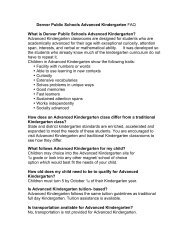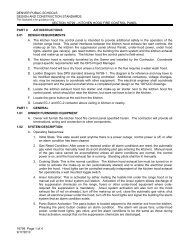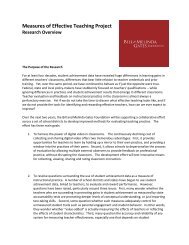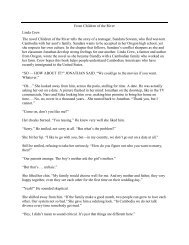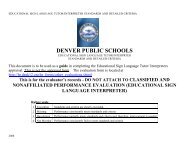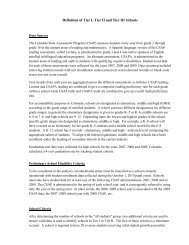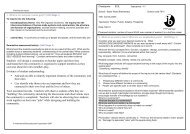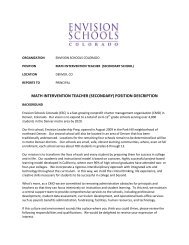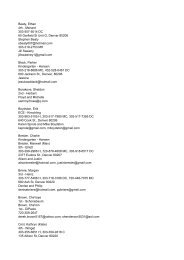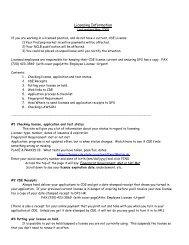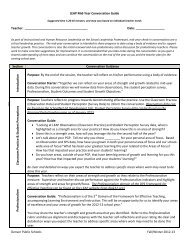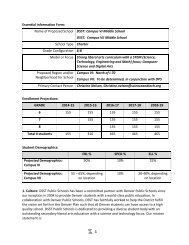Sharing the Planet- Living Things
Sharing the Planet- Living Things
Sharing the Planet- Living Things
Create successful ePaper yourself
Turn your PDF publications into a flip-book with our unique Google optimized e-Paper software.
Planning <strong>the</strong> inquiry<br />
And refer to thi<br />
1. What is our purpose/ overall goal? ( UbD Stage 1)<br />
To inquire into <strong>the</strong> following:<br />
transdisciplinary <strong>the</strong>me: How <strong>the</strong> World Works: An inquiry into <strong>the</strong> natural world and<br />
its laws; <strong>the</strong> interaction between <strong>the</strong> natural world (physical and biological) and human<br />
societies; how humans use <strong>the</strong>ir understanding of scientific principles; <strong>the</strong> impact of<br />
scientific and technological advances on society and on <strong>the</strong> environment.<br />
central idea: . <strong>Living</strong> things have certain requirements in order to grow and stay healthy.<br />
Summative assessment task(s): (UbD Stage 2)<br />
What should <strong>the</strong> students eventually be able to do as a result of this unit? What are <strong>the</strong><br />
possible ways of assessing students’ understanding of <strong>the</strong> central idea? What evidence,<br />
including student-initiated actions, will we look for? How will students REFLECT and<br />
SELF-ASSESS <strong>the</strong>ir learning? Consider performance tasks and o<strong>the</strong>r evidence.<br />
The summative assessment will include children drawing pictures to illustrate <strong>the</strong>ir<br />
understanding of what animals need to stay healthy. Question will be posed: What does<br />
this animal need to live? This may involve interviews with <strong>the</strong> students to enable <strong>the</strong>m to<br />
explain what is in <strong>the</strong>ir pictures.<br />
Assessment tool: a checklist. Was <strong>the</strong> student able to identify 2-3 things that a living<br />
thing needs to survive?<br />
into<br />
© International Baccalaureate Organization 2007<br />
Class/grade: ECE, MI, MIS Age group: 4-5 , MI/MIS (Various ages)<br />
School: Sabin World Elementary School code:7515<br />
Title: <strong>Living</strong> <strong>Things</strong><br />
Teacher(s): Parker, Pulido, Kalahar, Fitzpatrick<br />
Date:5/2011<br />
PYP planner<br />
Proposed duration: number of hours 50-60 over number of weeks 6 (in a half day<br />
class)<br />
2. What do we want to learn? What are our extablished goals? (UbDStage 1)<br />
Consider what you want your desired results to be. What<br />
KNOWLEDGE/UNDERSTANDINGS do you want students to walk away with? Content<br />
standards to be addressed? (See complete list in box 9)<br />
What are <strong>the</strong> key concepts (form, function, causation, change, connection, perspective,<br />
responsibility, reflection) to be emphasized within this inquiry?<br />
Key concepts:<br />
Function, causation, responsibility<br />
Related concepts: biodiversity, animals, classification<br />
What language functions will support student learning in <strong>the</strong> scope of <strong>the</strong> inquiry into <strong>the</strong><br />
central idea? Classify, compare, identify<br />
What lines of inquiry will define <strong>the</strong> scope of <strong>the</strong> inquiry into <strong>the</strong> central idea? (Students<br />
will understand that…)<br />
• Animals can be classified by many characteristics<br />
• Animals live in many types of shelters<br />
• Animals require certain things to survive<br />
What teacher questions/provocations will drive <strong>the</strong>se inquiries? (What essential questions<br />
can we ask to spark meaningful connections, provoke deep thought and inquiry,<br />
encourager transfer of knowledge by our students?)<br />
What kinds of living things are <strong>the</strong>re?<br />
Where do animals live?<br />
What do living things need?<br />
What characteristics do living things have?<br />
Provocation: Littleton Historic Museum, discuss living things <strong>the</strong>y observed, how <strong>the</strong>y<br />
live on a farm, how <strong>the</strong>y get <strong>the</strong> things <strong>the</strong>y need to survive. In conjunction with an<br />
illustrated KWL chart: Prior to <strong>the</strong> field trip, students draw what <strong>the</strong>y think a farm looks<br />
like. After <strong>the</strong> field trip, <strong>the</strong>y check <strong>the</strong>ir understanding and edit <strong>the</strong>ir drawing.
Planning <strong>the</strong> inquiry<br />
3. How might we know what we have learned? (UbD Stage 2)<br />
This column should be used in conjunction with “How best might we learn?”<br />
What are <strong>the</strong> possible ways of assessing students’ prior knowledge and skills? What<br />
evidence will we look for?<br />
Questioning around manipulatives and photos in <strong>the</strong> classroom. What do _________<br />
need to survive?<br />
Evidence to look for: students able to identify basic necessities living things need to stay<br />
alive, and that different living things require different necessities.<br />
What are <strong>the</strong> possible ways of assessing student learning in <strong>the</strong> context of <strong>the</strong> lines of<br />
inquiry? What evidence will we look for? (We will know students understand/know are<br />
able to do …. by…)<br />
Picture sorting for where animals live: sorting animals into <strong>the</strong>ir appropriate habitats.<br />
Venn Diagram: sorting farm animals & non farm animals and <strong>the</strong>ir requirements to grow<br />
and stay healthy.<br />
Sorting around different classifications of animals.<br />
5. What resources need to be ga<strong>the</strong>red? (UbD Stage 3)<br />
What people, places, audio-visual materials, related literature, music, art, computer<br />
software, etc, will be available?<br />
Video: On <strong>the</strong> Farm; book list from <strong>the</strong> tub; animal toys and manipulatives; classification<br />
of animal books: vertebrate, invertebrate; mammals, insects, etc<br />
How will <strong>the</strong> classroom environment, local environment, and/or <strong>the</strong> community be used to<br />
facilitate <strong>the</strong> inquiry?<br />
Zoo and farm field trips; learning/inquiry centres: classification and sorting; Littleton<br />
Historical Museum<br />
© International Baccalaureate Organization 2007<br />
4. How best might we learn? (UbD Stage 3- Performance Tasks)<br />
What are <strong>the</strong> learning experiences suggested by <strong>the</strong> teacher and/or students to<br />
encourage <strong>the</strong> students to engage with <strong>the</strong> inquiries and address <strong>the</strong> driving questions?<br />
(Consider <strong>the</strong> WHERETO prompting listed in box 10.)<br />
• Books and literature: read aloud connections to <strong>the</strong> central idea can you be more specific<br />
here? Add books to resources that you typically use.<br />
• Webbing Project: Big book read review (Polar Bear, Polar Bear: tie to zookeeper), picture<br />
walk through a book, modeling “I’m wondering” followed by webbing questions (teacher<br />
modeled; learning <strong>the</strong> words to ask questions; followed by student questions); students<br />
draw pictures based on <strong>the</strong> question <strong>the</strong>y are interested in. Tie questions to visit to <strong>the</strong><br />
zoo, “What will you want to ask <strong>the</strong> zoo keeper?”<br />
• Field trips: Littleton Historic Museum, discuss living things <strong>the</strong>y observed, how <strong>the</strong>y live on<br />
a farm, how <strong>the</strong>y get <strong>the</strong> things <strong>the</strong>y need to survive.<br />
• Toys and manipulatives: barn, plastic animals, puzzles. Observe how students interact<br />
with material. Students given <strong>the</strong> opportunity to play with manipulatives and describe what<br />
<strong>the</strong>y are doing.<br />
• Movie, artifacts What do you do with <strong>the</strong>se?<br />
• Class chart of needs, classifying & sorting activities- explain<br />
• Drawings and illustrations, discussions, dramatic play<br />
• Classifying animals: vertebrate/invertebrate; mammal, amphibian, reptile, bird, etc.<br />
• Zoo trip?<br />
What opportunities will occur for transdisciplinary skills development and for <strong>the</strong><br />
development of <strong>the</strong> attributes of <strong>the</strong> learner profile? What key SKILLS will students<br />
acquire as a result of this unit?<br />
Transdisciplinary Skills<br />
Thinking Skills :<br />
• Application: discussions around how to keep living things (pets, wild animals, domestic<br />
animals) safe and healthy<br />
• Analysis – classifying & sorting<br />
• Comprehension/Acquisition of knowledge: literature and movies: <strong>the</strong>se are used to build<br />
background knowledge, generate questions and build vocabulary around central idea.<br />
Teachers use books and movies to assess student’s background knowledge as well.<br />
Research Skills:<br />
• Formulating questions, observing, collecting data, record data with drawings; interpreting<br />
w/ Venn Diagram; present research when talk about what <strong>the</strong>y do<br />
Learner Profile<br />
Communicators: reading, speaking; viewing’ listening; drawing/writing<br />
Inquirers: as <strong>the</strong>y pose questions and wonder; knowledgeable/research<br />
Thinkers: sorting, comparing/contrasting<br />
Attitudes:<br />
• Empathy- for how animals feel if <strong>the</strong>y are treated well, or mistreated<br />
• Respect: for animals<br />
• Curiosity: to learn about individual animals (this comes pretty naturally throughout<br />
<strong>the</strong> unit!)
Reflecting on <strong>the</strong> inquiry<br />
6. To what extent did we achieve our purpose?<br />
Refer back to Box 1 to answer <strong>the</strong>se questions.<br />
Assess <strong>the</strong> outcome of <strong>the</strong> inquiry by providing evidence of students’ understanding of <strong>the</strong><br />
central idea. The reflections of all teachers involved in <strong>the</strong> planning and teaching of <strong>the</strong><br />
inquiry should be included.<br />
Children were able to classify where animals live (i.e. zoo, farm, ocean)- able to identify<br />
various shelters and able to identify <strong>the</strong> needs of an animal.<br />
How you could improve on <strong>the</strong> assessment task(s) so that you would have a more<br />
accurate picture of each student’s understanding of <strong>the</strong> central idea.<br />
This worked well. We want to keep it <strong>the</strong> same for next year.<br />
What opportunities were <strong>the</strong>re for student self-assessment/reflection?<br />
- Participating in animal guessing games after being given 3 clues<br />
- Drawings and “storytelling”<br />
- Role-playing and acting out; costumes- we could see <strong>the</strong> students working<br />
through <strong>the</strong> ideas and knowledge from class.<br />
What was <strong>the</strong> evidence that connections were made between <strong>the</strong> central idea and <strong>the</strong><br />
transdisciplinary <strong>the</strong>me?<br />
• Using a KWL chart throughout <strong>the</strong> unit and updating as new information is<br />
learned.<br />
• Verbal understandings<br />
• More detailed illustrations<br />
© International Baccalaureate Organization 2007<br />
7. To what extent did we include <strong>the</strong> elements of <strong>the</strong> PYP?<br />
What were <strong>the</strong> learning experiences that enabled students to:<br />
• develop an understanding of <strong>the</strong> concepts identified in “What do we want to learn?”<br />
• demonstrate <strong>the</strong> learning and application of particular transdisciplinary skills?<br />
• develop particular attributes of <strong>the</strong> learner profile and/or attitudes?<br />
• Responsibility: Understanding <strong>the</strong> needs and requirements of animals to survive-<br />
through field trips to <strong>the</strong> zoo and farm, role playing in <strong>the</strong> classroom “barn” and “zoo”,<br />
using <strong>the</strong> puppet <strong>the</strong>ater to explore <strong>the</strong>se ideas and apply <strong>the</strong>m to play.<br />
• Relatization that animals and people have similar needs: shelter, food, water, hygiene<br />
• Curiosity: examining a variety of books, cideos and websites, <strong>the</strong> students<br />
demonstrated a natural curiosity to learn more about animals.<br />
In each case, explain your selection.
Reflecting on <strong>the</strong> inquiry<br />
8. What student-initiated inquiries arose from <strong>the</strong> learning?<br />
Record a range of student-initiated inquiries and student questions and highlight any that were<br />
incorporated into <strong>the</strong> teaching and learning.<br />
Do all animals live at <strong>the</strong> farm/zoo?<br />
Do <strong>the</strong>y eat <strong>the</strong> same thing?<br />
Do <strong>the</strong>y sleep laying down?<br />
Do <strong>the</strong>y like <strong>the</strong> cold?<br />
Do <strong>the</strong>y like ice cream?<br />
At this point teachers should go back to box 2 “What do we want to learn?” and highlight <strong>the</strong><br />
teacher questions/provocations that were most effective in driving <strong>the</strong> inquiries.<br />
What student-initiated actions arose from <strong>the</strong> learning?<br />
Record student-initiated actions taken by individuals or groups showing <strong>the</strong>ir ability to reflect,<br />
to choose and to act. How did <strong>the</strong> students show <strong>the</strong>ir transfer of understanding?<br />
• Drawings<br />
• Role playing<br />
• “story-telling”<br />
• Acting out<br />
• Animal guessing game- who am I?<br />
• Puppet <strong>the</strong>ater<br />
9. Teacher notes (To do list before teaching this unit again):<br />
Order Zoo admission wrist bands ahead of time! (Went extremely well this year)j.<br />
Ask DPS to unlock certain websites.<br />
Content standards addressed through this inquiry:
10. How will <strong>the</strong> language functions needed to<br />
understand this unit be developed?<br />
Language function:<br />
Sentence frames:<br />
Grammar/Syntax:<br />
Phrasing:<br />
Vocabulary:<br />
© International Baccalaureate Organization 2007<br />
Language function:<br />
Sentence frames:<br />
Grammar/Syntax:<br />
Phrasing:<br />
Vocabulary:<br />
Language function:<br />
Sentence frames:<br />
Grammar/Syntax:<br />
Phrasing:<br />
Vocabulary:




